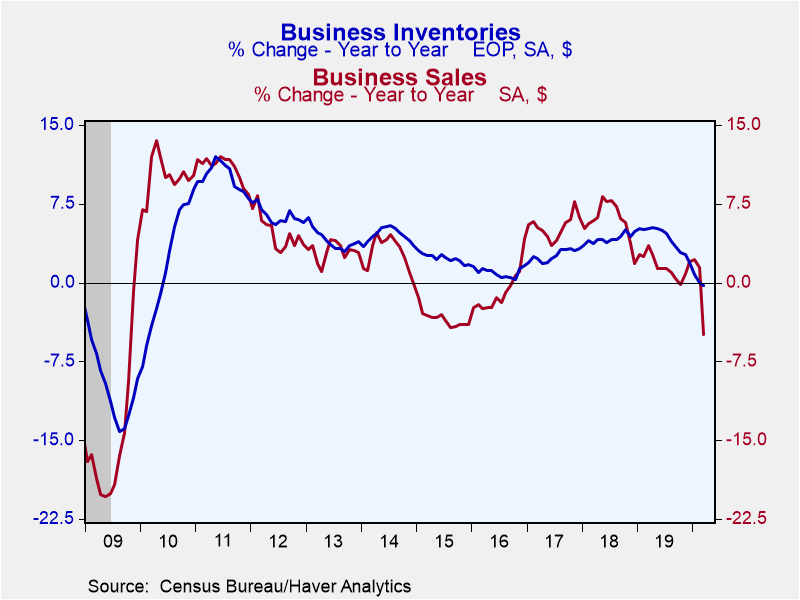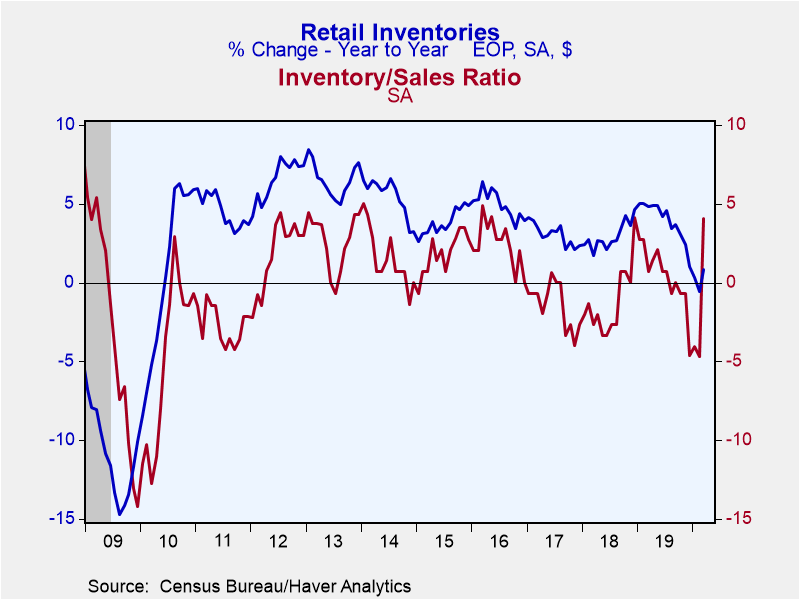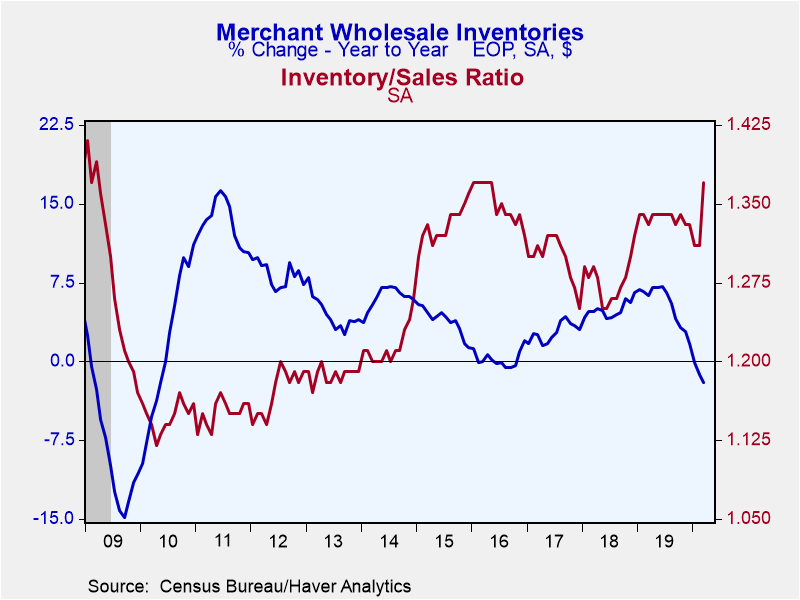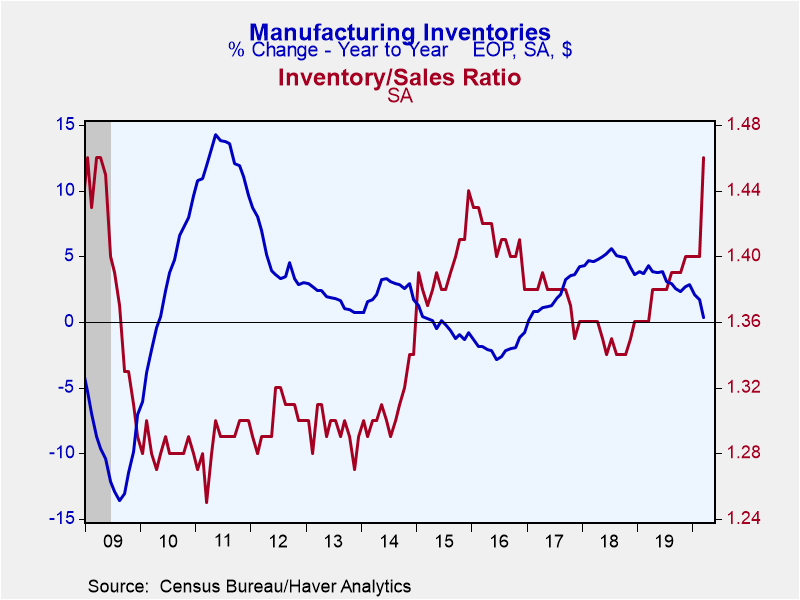 Global| May 15 2020
Global| May 15 2020U.S. Business Inventories and Sales Decline in March
Summary
Total business inventories fell 0.2% m/m (-0.3% y/y) in March, following a revised 0.3% m/m decline in February. The March result equaled the Informa Global Markets survey forecast. Business sales dropped 5.2% m/m (-4.9% y/y) after a [...]
Total business inventories fell 0.2% m/m (-0.3% y/y) in March, following a revised 0.3% m/m decline in February. The March result equaled the Informa Global Markets survey forecast. Business sales dropped 5.2% m/m (-4.9% y/y) after a more orderly 0.4% decrease the month before, which was modestly revised from -0.5%. With the sizable decline in sales and the modest decline in inventories, the inventory/sales ratio rose to 1.45 in March from 1.38 the month before. This was the largest monthly move since November 2008, in the midst of the Great Recession, and the highest ratio since April 2009. All these data were revised moderately this month in the annual seasonal adjustment revisions.
Retail inventories rose by 1.0% in March (+0.8% y/y) after February's 0.3% decline. The sizable increase in total retail inventories reflected a plunge in motor vehicle dealers' sales of 25.7%, which pushed those inventories up 4.8% (also 4.8% y/y), the largest monthly increase since 4.9% in July 1992. Other retailers' inventories actually declined 1.0% (+0.2% y/y) after a miniscule reduction in February. Wholesale inventories fell 0.8% m/m in March, their seventh consecutive monthly decrease, contributing to a 2.0% decline year-on-year, the largest such decline since April 2010. Manufacturing inventories fell 0.8% (+0.3% y/y) after February's revised 0.1% increase.
Sales at retail stores (excluding food services) dropped 5.3% in March, actually revised to a smaller decline from the 6.2% reported last month, Clearly, the April data make the March data look more moderate still, even though at the time Sandy Batten characterized them here as a "stunning . . . collapse." That is what they looked like then, while April is now seen as a 15.1% plunge. Wholesale sector sales fell 5.2% m/m (also 5.2% y/y) in March. Shipments from the factory sector also fell 5.2% (-6.5% y/y) after being unchanged in February
Inventory-to-sales ratios increased markedly in March. The overall total rose from 1.38 in February to 1.45, the highest since 1.47 in March 2009. The retail sector I/S ratio rose from 1.43 in February to 1.53 in March; this sizable increase was, notably, all at motor vehicle & parts dealers. Excluding those, the I/S ratio for other retailers actually declined from 1.21 to 1.19 and is tied for the lowest ever (data back to 1967). The auto sector's ratio leaped from 2.18 to 3.07, a new high; the previous record was 2.69 in December 2008. For merchant wholesalers, the I/S ratio rose to 1.37 from 1.31stayed at 1.31; this ratio has a relatively volatile pattern and this March move, while sizable, is not extraordinary. The factory sector I/S ratio was rose to 1.46 from 1.40, tied with the high during the Great Recession in January, March and April of 2009. Earlier history is marked by larger ratios as inventory control techniques were less strategic than they have been in recent years.
The manufacturing and trade data are in Haver's USECON database.
| Manufacturing & Trade | Mar | Feb | Jan | Mar Y/Y | 2019 | 2018 | 2017 |
|---|---|---|---|---|---|---|---|
| Business Inventories (% chg) | -0.2 | -0.3 | -0.3 | -0.3 | 1.9 | 4.9 | 3.2 |
| Retail | 1.0 | -0.3 | 0.0 | 0.8 | 1.0 | 4.6 | 2.4 |
| Retail excl. Motor Vehicles | -1.0 | 0.0 | 0.3 | 0.2 | 1.9 | 3.7 | 2.2 |
| Merchant Wholesalers | -0.8 | -0.7 | -0.6 | -2.0 | 1.7 | 6.5 | 3.0 |
| Manufacturing | -0.8 | 0.1 | -0.2 | 0.3 | 2.8 | 3.6 | 4.2 |
| Business Sales (% chg) | |||||||
| Total | -5.2 | -0.4 | 0.6 | -4.9 | 1.6 | 5.9 | 5.3 |
| Retail | -5.3 | -0.5 | 0.8 | -2.7 | 3.4 | 4.2 | 4.6 |
| Retail excl. Motor Vehicle | 0.7 | -0.5 | 0.8 | 3.5 | 3.3 | 5.1 | 4.9 |
| Merchant Wholesalers | -5.2 | -0.7 | 1.3 | -5.2 | 0.6 | 6.8 | 6.6 |
| Manufacturing | -5.2 | 0.0 | -0.3 | -6.5 | 1.0 | 6.6 | 4.7 |
| I/S Ratio | |||||||
| Total | 1.45 | 1.38 | 1.38 | 1.38 | 1.39 | 1.36 | 1.38 |
| Retail | 1.53 | 1.43 | 1.43 | 1.47 | 1.46 | 1.46 | 1.48 |
| Retail excl. Motor Vehicles | 1.19 | 1.21 | 1.21 | 1.23 | 1.22 | 1.22 | 1.24 |
| Merchant Wholesalers | 1.37 | 1.31 | 1.31 | 1.33 | 1.34 | 1.28 | 1.30 |
| Manufacturing | 1.46 | 1.40 | 1.40 | 1.36 | 1.38 | 1.35 | 1.38 |
Carol Stone, CBE
AuthorMore in Author Profile »Carol Stone, CBE came to Haver Analytics in 2003 following more than 35 years as a financial market economist at major Wall Street financial institutions, most especially Merrill Lynch and Nomura Securities. She has broad experience in analysis and forecasting of flow-of-funds accounts, the federal budget and Federal Reserve operations. At Nomura Securites, among other duties, she developed various indicator forecasting tools and edited a daily global publication produced in London and New York for readers in Tokyo. At Haver Analytics, Carol is a member of the Research Department, aiding database managers with research and documentation efforts, as well as posting commentary on select economic reports. In addition, she conducts Ways-of-the-World, a blog on economic issues for an Episcopal-Church-affiliated website, The Geranium Farm. During her career, Carol served as an officer of the Money Marketeers and the Downtown Economists Club. She has a PhD from NYU's Stern School of Business. She lives in Brooklyn, New York, and has a weekend home on Long Island.









